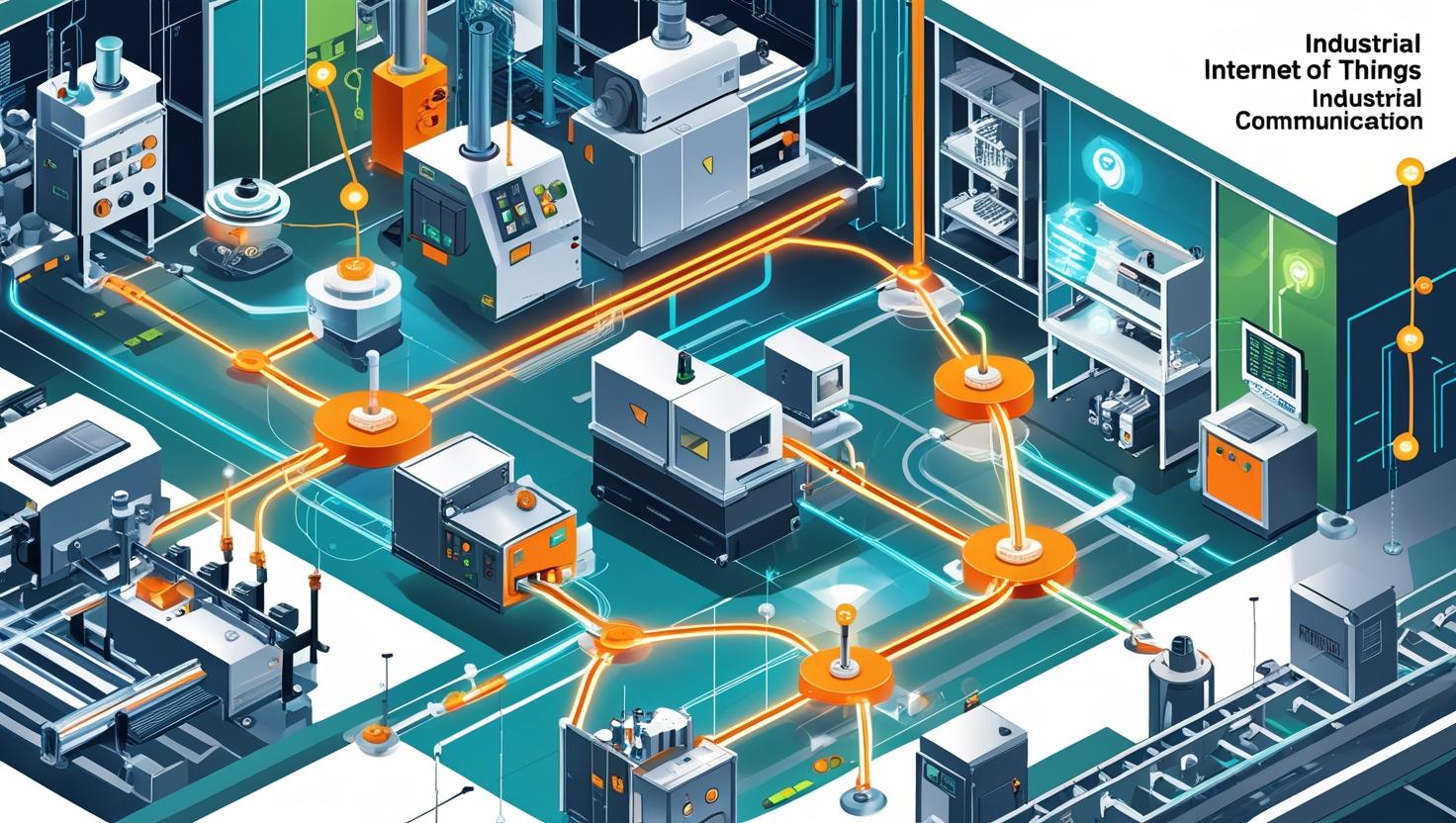The Industrial Internet of Things (IIoT) has emerged as a revolutionary force, fundamentally altering the landscape of industrial operations across various sectors. By integrating advanced sensors, cloud computing, and real-time analytics, IIoT enables seamless connectivity and data exchange, driving unprecedented efficiency and innovation. The impact of IIoT on the industrial communication market is particularly profound, as it redefines how devices, machines, and systems interact within industrial environments. This transformation is reshaping communication protocols, enhancing network reliability, and fostering the development of smart factories. As industries increasingly adopt IIoT technologies, understanding the impact of IIoT on the industrial communication market becomes essential for stakeholders aiming to stay competitive in a rapidly evolving digital era.
The industrial communication market, which encompasses technologies and protocols facilitating data transfer in industrial settings, has experienced significant growth due to IIoT adoption. From manufacturing to energy, IIoT-driven solutions are optimizing operations and enabling predictive maintenance, thereby increasing the demand for robust communication networks. This article delves into the multifaceted impact of IIoT on the industrial communication market, exploring key trends, challenges, and opportunities while maintaining a focus on how these advancements are reshaping industrial ecosystems.

Evolution of Industrial Communication Technologies in the Context of IIoT Integration
Industrial communication has evolved dramatically over the decades, transitioning from analog systems to sophisticated digital networks. Historically, industrial communication relied on wired protocols like Modbus and Profibus, which provided reliable but limited connectivity. The advent of IIoT has accelerated the shift toward wireless, IP-based, and cloud-integrated communication systems, significantly enhancing the impact of IIoT on the industrial communication market. Modern protocols such as OPC UA, MQTT, and Time-Sensitive Networking (TSN) are designed to handle the high-volume, low-latency data exchange required by IIoT applications.
The integration of IIoT has necessitated the development of communication technologies capable of supporting real-time data processing and interoperability across diverse devices. For instance, TSN enables deterministic communication, ensuring that critical data is transmitted with minimal delay, which is vital for applications like autonomous robotics. Similarly, MQTT’s lightweight messaging protocol is ideal for IIoT environments with constrained bandwidth, facilitating efficient data transfer between sensors and cloud platforms. These advancements underscore the transformative impact of IIoT on the industrial communication market, as they enable industries to achieve greater operational agility and scalability.
Key Drivers Amplifying the Impact of IIoT on the Industrial Communication Market Dynamics
Several factors are propelling the impact of IIoT on the industrial communication market, with technological advancements and market demands playing pivotal roles. The proliferation of smart sensors and connected devices has created a surge in data generation, necessitating robust communication infrastructures to handle this influx. Industries are increasingly prioritizing real-time insights to optimize processes, reduce downtime, and enhance decision-making, further amplifying the need for advanced communication networks.
The push for Industry 4.0, characterized by automation and data-driven manufacturing, is another significant driver. IIoT technologies enable the creation of cyber-physical systems, where machines communicate seamlessly to coordinate tasks. This interconnectedness relies on high-speed, secure, and scalable communication protocols, highlighting the profound impact of IIoT on the industrial communication market. Additionally, the growing emphasis on predictive maintenance and asset management has spurred investments in IIoT solutions, as companies seek to leverage data analytics to minimize operational disruptions.
Role of Advanced Communication Protocols in Facilitating IIoT-Driven Industrial Transformation
Advanced communication protocols are at the heart of IIoT’s influence on industrial systems, enabling the seamless exchange of data across complex networks. The impact of IIoT on the industrial communication market is evident in the widespread adoption of protocols like OPC UA, which provides a standardized framework for secure and reliable data exchange between heterogeneous systems. OPC UA’s platform-independent architecture makes it ideal for IIoT environments, where diverse devices from multiple vendors must interoperate.
MQTT, another critical protocol, supports lightweight data transmission, making it suitable for IIoT applications in remote or resource-constrained settings. Its publish-subscribe model minimizes network overhead, ensuring efficient communication between edge devices and cloud platforms. Furthermore, the emergence of 5G technology has bolstered the impact of IIoT on the industrial communication market by offering ultra-low latency and high-bandwidth connectivity. 5G enables real-time applications such as remote machine control and augmented reality-based maintenance, further driving the demand for advanced communication infrastructures.
Enhancing Network Reliability and Security Through IIoT Innovations in Industrial Communication
As IIoT adoption grows, ensuring network reliability and security has become a critical priority. The impact of IIoT on the industrial communication market is reflected in the development of technologies designed to address these concerns. IIoT-driven networks must handle vast amounts of data while maintaining uptime and protecting against cyber threats. Innovations such as edge computing and software-defined networking (SDN) are enhancing network resilience by decentralizing data processing and optimizing traffic management.
Security is a paramount concern, as interconnected systems are vulnerable to cyberattacks. The impact of IIoT on the industrial communication market includes the integration of advanced encryption, authentication, and intrusion detection systems to safeguard data integrity. Protocols like OPC UA incorporate robust security features, such as end-to-end encryption, to protect against unauthorized access. Additionally, blockchain-based solutions are being explored to enhance data traceability and trust in IIoT ecosystems, further strengthening the security framework of industrial communication networks.
Challenges and Barriers Hindering the Full Realization of IIoT’s Impact on Industrial Communication
Despite its transformative potential, the impact of IIoT on the industrial communication market faces several challenges. Interoperability remains a significant hurdle, as legacy systems often lack compatibility with modern IIoT protocols. Retrofitting existing infrastructure to support IIoT connectivity can be costly and complex, deterring some organizations from fully embracing these technologies. Additionally, the lack of standardized communication protocols across industries can lead to fragmentation, hindering seamless data exchange.
Cybersecurity risks also pose a barrier to IIoT adoption. As industrial networks become more connected, they are increasingly exposed to sophisticated cyber threats. Ensuring robust security measures without compromising network performance is a delicate balance. Furthermore, the high initial investment required for IIoT implementation, including hardware, software, and skilled personnel, can be prohibitive for small and medium-sized enterprises. Addressing these challenges is crucial to maximizing the impact of IIoT on the industrial communication market.
Opportunities for Growth and Innovation Stemming from IIoT’s Influence on Industrial Communication
The impact of IIoT on the industrial communication market presents numerous opportunities for growth and innovation. The increasing demand for real-time data analytics and automation is driving investments in next-generation communication technologies. For instance, the integration of artificial intelligence (AI) with IIoT networks enables predictive analytics, allowing industries to anticipate equipment failures and optimize maintenance schedules. This convergence of AI and IIoT is creating new revenue streams for communication technology providers.
The rise of smart factories, powered by IIoT, is another significant opportunity. Smart factories leverage interconnected systems to achieve higher productivity and flexibility, relying on advanced communication networks to coordinate operations. The impact of IIoT on the industrial communication market is also evident in the growing adoption of wireless technologies like Wi-Fi 6 and private 5G networks, which offer greater mobility and scalability. These innovations are enabling industries to explore new business models, such as as-a-service offerings, further expanding market potential.
Download PDF Brochure @ https://www.marketsandmarkets.com/pdfdownloadNew.asp?id=146536397
Regional Insights into the Global Impact of IIoT on the Industrial Communication Market Expansion
The impact of IIoT on the industrial communication market varies across regions, driven by differences in industrial maturity, technological adoption, and regulatory frameworks. North America, with its advanced manufacturing sector and strong focus on Industry 4.0, leads in IIoT-driven communication innovations. The region’s robust investment in 5G and cloud infrastructure has accelerated the deployment of IIoT solutions, enhancing the industrial communication market’s growth.
In Europe, initiatives like the EU’s Digital Single Market and Germany’s Industrie 4.0 strategy are fostering IIoT adoption, particularly in automotive and aerospace industries. The Asia-Pacific region, led by China and Japan, is witnessing rapid growth due to large-scale manufacturing and government support for smart industrial initiatives. Emerging economies in Latin America and Africa are gradually adopting IIoT, though challenges like infrastructure limitations may slow progress. Understanding these regional dynamics is critical to assessing the global impact of IIoT on the industrial communication market.

Future Trends Shaping the Long-Term Impact of IIoT on the Industrial Communication Market
The future of the industrial communication market is closely tied to the evolution of IIoT technologies. Emerging trends, such as the integration of digital twins and augmented reality, are expected to further amplify the impact of IIoT on the industrial communication market. Digital twins, which create virtual replicas of physical assets, rely on real-time data exchange facilitated by advanced communication networks. Similarly, augmented reality applications for remote maintenance and training require low-latency, high-bandwidth connectivity.
The adoption of open-source communication protocols is another trend poised to shape the market. Open-source solutions promote interoperability and reduce vendor lock-in, enabling industries to build flexible IIoT ecosystems. Additionally, the convergence of IT and operational technology (OT) is blurring traditional boundaries, creating unified communication platforms that enhance efficiency. These trends underscore the ongoing and future impact of IIoT on the industrial communication market, positioning it as a cornerstone of industrial transformation.
Conclusion: Strategic Implications of IIoT’s Impact on the Industrial Communication Market
The impact of IIoT on the industrial communication market is undeniable, as it drives innovation, efficiency, and connectivity across industrial ecosystems. By enabling real-time data exchange, advanced analytics, and automation, IIoT is transforming how industries operate, creating opportunities for growth while presenting new challenges. Stakeholders must invest in robust communication infrastructures, prioritize cybersecurity, and address interoperability issues to fully capitalize on IIoT’s potential.
As the industrial communication market continues to evolve, staying ahead of technological trends and regional dynamics will be crucial. The impact of IIoT on the industrial communication market is not just a technological shift but a strategic imperative for industries aiming to thrive in the digital age. By embracing IIoT-driven solutions, businesses can unlock new levels of productivity, resilience, and competitiveness, shaping the future of industrial communication.
FAQs: Addressing Common Questions About the Impact of IIoT on the Industrial Communication Market
What is the primary impact of IIoT on the industrial communication market?
The primary impact of IIoT on the industrial communication market is the enhancement of connectivity, enabling real-time data exchange and automation across industrial systems.
How does IIoT improve communication network reliability?
IIoT improves network reliability through edge computing, software-defined networking, and advanced protocols like TSN, ensuring consistent data transmission.
What are the main challenges of IIoT adoption in industrial communication?
Challenges include interoperability issues, cybersecurity risks, high initial costs, and the complexity of integrating legacy systems with IIoT technologies.
Which protocols are most critical for IIoT-driven communication?
Protocols like OPC UA, MQTT, and TSN are critical, as they support secure, efficient, and real-time data exchange in IIoT environments.
How does 5G contribute to the impact of IIoT on the industrial communication market?
5G provides ultra-low latency and high-bandwidth connectivity, enabling real-time applications like remote machine control and augmented reality.
What future trends will shape the impact of IIoT on the industrial communication market?
Trends like digital twins, augmented reality, open-source protocols, and IT-OT convergence will drive further innovation in industrial communication.
